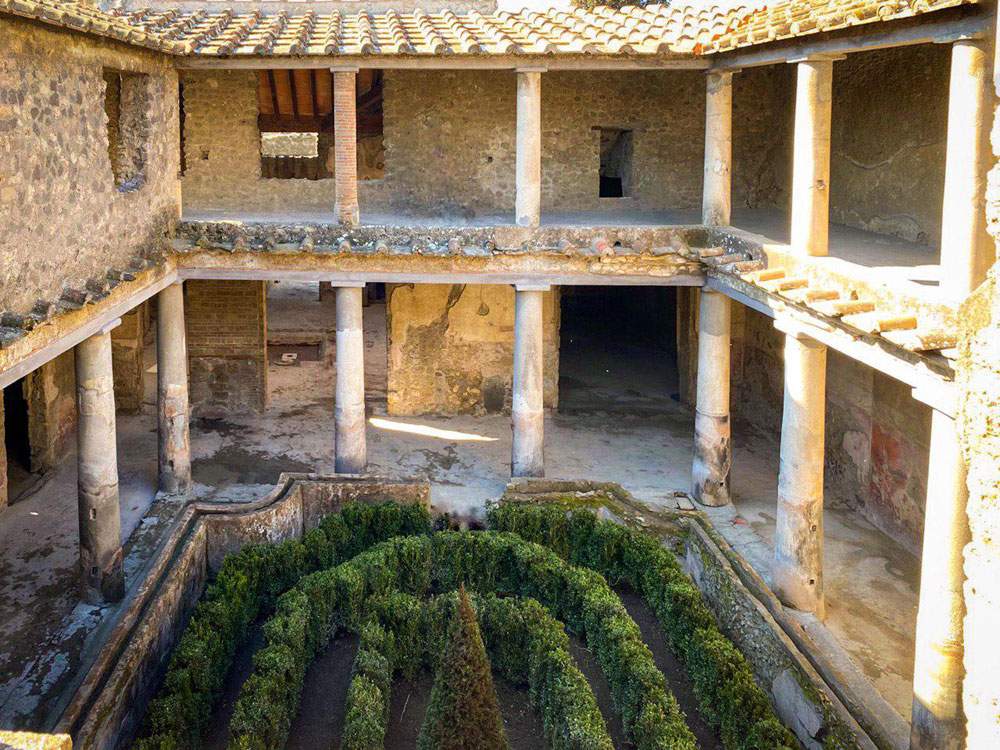After fifteen months of work, the site for the securing of Pompeii’s Regiones I, II and III has been concluded: directed by a team of architects, archaeologists, engineers and restorers, it carried out specific structural restoration of the masonry, the securing of the decorative apparatuses and the rebuilding of the roofs, as well as the controlled installation of safeguards to safeguard specific situations of instability of the masonry structures.
As a result, three domus were reopened: the House of the Lovers, the House of the Nave Europa, and the House of the Orchard; in particular, the former was reopened after forty years, as it had been closed to the public since the Irpinia earthquake in the 1980s.
This was discovered in 1933 and owes its name to the verse engraved in a small picture with ducks at the bottom of the peristyle, which translated reads “Lovers lead, like bees, a life sweet as honey.” Over the years, the state of preservation of the House of the Lovers had become such that even technicians were prevented from entering it. The most notable feature of the dwelling is the presence and almost complete preservation of the second floor of the peristyle (colonnaded garden), which was once accessible via a staircase in the northern portico (traces of which are visible on the back wall). This second floor seems to have been added in the first century AD, and the state of preservation made it possible to recover the original configuration of this space from the very beginning, restoring to perception and knowledge an architectural solution, that of the double-order peristyle, which to this day represents a unicum in Pompeii.
The House of the Ship Europa takes its name from the large graffito carved on the north wall of the peristyle, where a large cargo ship, named Europa, is depicted flanked by smaller vessels. At present the domus has a large peristyle with numerous rooms arranged in succession, and the monumental tufa columns of the peristyle and the I-style decorations in some rooms have been preserved. Probably, in the last phase of the life of the city of Pompeii, the building was intended for an agricultural type of productive activity.
Finally, in the House of the Orchard, lemon and strawberry trees, fruit and ornamental plants, fluttering birds and a fig tree to which a snake is clinging are visible in the cubicles: lush vegetation painted on the walls of this dwelling located on Via dell’Abbondanza, which preserves one of the most significant examples of garden painting found in the city. The frescoes depict in one of the rooms a bright garden, imagined in the daytime, with a precision of detail that makes it possible to recognize the plant species, and in the other room, a garden immersed in the darkness of the night, with three trees of different sizes, including the large fig tree with the snake, an omen of prosperity. In addition, in some rooms, the depictions are enriched with Egyptian motifs with references to Isis, probably a sign of devotion to the goddess on the part of the owner.The domus has the classic atrium layout, around which various rooms are arranged, and in the rear a green space with a summer triclinium, used during the hot season.
Satisfied is the director of the Pompeii Archaeological Park, Massimo Osanna, who said, “In Pompeii it is no longer the time for emergencies. We have before us new and important challenges for the protection, knowledge and enhancement of the excavations and the territory.”
“Pompeii is a story of rebirth and redemption, a model for all of Europe in the management of EU funds. A place where there has been a return to research and new archaeological excavations thanks to the long and silent work of the many cultural heritage professionals who have contributed to the extraordinary results that are before everyone’s eyes and a source of pride for Italy,” added MiBACT Minister Dario Franceschini.
Pictured: the House of the Lovers. Ph.Credit MiBACT
 |
| After 40 years, the House of the Lovers in Pompeii reopens |
Warning: the translation into English of the original Italian article was created using automatic tools. We undertake to review all articles, but we do not guarantee the total absence of inaccuracies in the translation due to the program. You can find the original by clicking on the ITA button. If you find any mistake,please contact us.